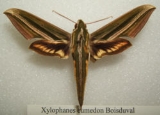
Xylophanes eumedon
Encyclopedia
Xylophanes eumedon is a moth
of the Sphingidae
family. It is known from Mexico
.
It is similar to Xylophanes aristor
but smaller and the forewing pattern is much more contrasted. It is distinguishable from most related species by the partial fusion and apical pinkish flush of the pale yellow spots of the median band of the hindwing upperside. The upperside of the abdomen has two narrow, pale lines, divided medially by a sharp, thin brown line of the same width. There is also a black basal patch and conspicuous longitudinal golden-yellow bands on either side of the anterior part of the abdomen. The first postmedian line on the forewing upperside is broad and very well-marked. The second is fused to the first. The interspaces between the first and third postmedian lines are very pale. The apical area on the forewing underside is pale buff on the costa, contrasting strongly with the orange-yellow ground colour. The median band of the hindwing upperside has pale yellow spots which are indistinct. The edges of these sports are suffused with orange-brown and in general, the three apical spots are more or less fused.
Adults are probably on wing year round.
The larvae possibly feed on Psychotria panamensis, Psychotria nervosa
and Pavonia guanacastensis.
Moth
A moth is an insect closely related to the butterfly, both being of the order Lepidoptera. Moths form the majority of this order; there are thought to be 150,000 to 250,000 different species of moth , with thousands of species yet to be described...
of the Sphingidae
Sphingidae
Sphingidae is a family of moths , commonly known as hawk moths, sphinx moths and hornworms, that includes about 1,200 species . It is best represented in the tropics but there are species in every region . They are moderate to large in size and are distinguished among moths for their rapid,...
family. It is known from Mexico
Mexico
The United Mexican States , commonly known as Mexico , is a federal constitutional republic in North America. It is bordered on the north by the United States; on the south and west by the Pacific Ocean; on the southeast by Guatemala, Belize, and the Caribbean Sea; and on the east by the Gulf of...
.
It is similar to Xylophanes aristor
Xylophanes aristor
Xylophanes aristor is a moth of the Sphingidae family. It is known from Guatemala to Venezuela, Ecuador and probably Colombia.The forewing upperside ground colour and the upperside of the body is olive-green and the forewing underside is orange...
but smaller and the forewing pattern is much more contrasted. It is distinguishable from most related species by the partial fusion and apical pinkish flush of the pale yellow spots of the median band of the hindwing upperside. The upperside of the abdomen has two narrow, pale lines, divided medially by a sharp, thin brown line of the same width. There is also a black basal patch and conspicuous longitudinal golden-yellow bands on either side of the anterior part of the abdomen. The first postmedian line on the forewing upperside is broad and very well-marked. The second is fused to the first. The interspaces between the first and third postmedian lines are very pale. The apical area on the forewing underside is pale buff on the costa, contrasting strongly with the orange-yellow ground colour. The median band of the hindwing upperside has pale yellow spots which are indistinct. The edges of these sports are suffused with orange-brown and in general, the three apical spots are more or less fused.
Adults are probably on wing year round.
The larvae possibly feed on Psychotria panamensis, Psychotria nervosa
Psychotria nervosa
Psychotria nervosa, also known as wild coffee, is a shade tolerant medium-sized shrub native to Florida as well as Central and South America. It produces "small, red, ellipsoid fruit" that resemble "the true coffee bean" in shape and attract birds...
and Pavonia guanacastensis.
External links
- Xylophanes eumedon Sphingidae of the Americas

